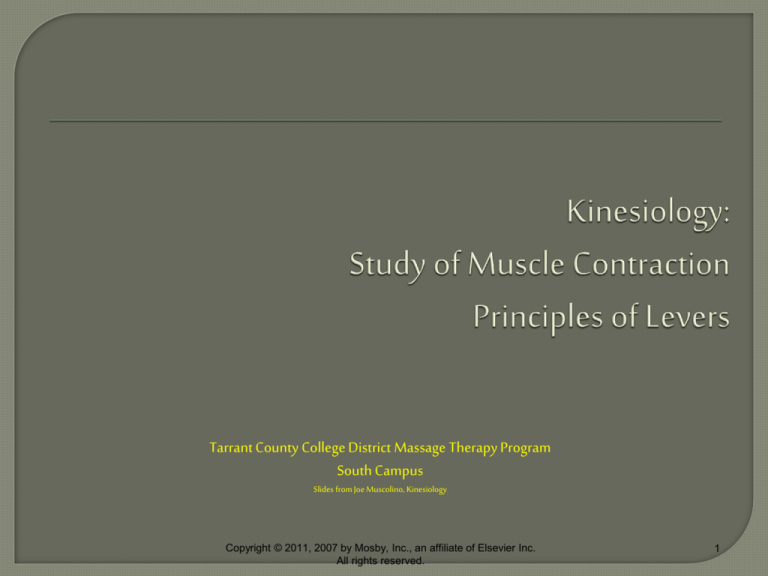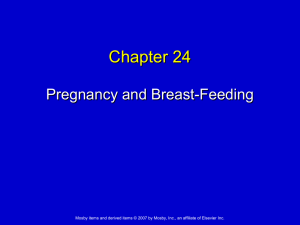
Tarrant County College District Massage Therapy Program
South Campus
Slides from Joe Muscolino, Kinesiology
Copyright © 2011, 2007 by Mosby, Inc., an affiliate of Elsevier Inc.
All rights reserved.
1
Describe
how a muscle can have a partial
contraction, and explain the meaning of
the Henneman size principle.
Explain the difference between the
intrinsic strength of a muscle and the
extrinsic strength of a muscle.
Copyright © 2011, 2007 by Mosby, Inc., an affiliate of Elsevier Inc.
All rights reserved.
2
Describe
the various types of muscle
fiber architecture, and explain the
advantages/disadvantages of
longitudinal versus pennate muscles.
Describe active tension and passive
tension of a muscle.
Copyright © 2011, 2007 by Mosby, Inc., an affiliate of Elsevier Inc.
All rights reserved.
3
Hierarchy
of motor unit recruitment:
• Weak contraction = small motor unit
• Stronger = increasingly large motor units in
addition to smaller motor units
Hierarchy
known as the Henneman size
principle
Copyright © 2011, 2007 by Mosby, Inc., an affiliate of Elsevier Inc.
All rights reserved.
4
If
every motor unit of a muscle contracts,
the muscle contracts at 100% of its
strength.
If only some motor units contract, the
muscle will have a partial contraction.
Copyright © 2011, 2007 by Mosby, Inc., an affiliate of Elsevier Inc.
All rights reserved.
5
Longitudinal
muscles: fibers run
longitudinally
Categories of longitudinal muscle
• Fusiform (spindle)
• Strap
• Rectangular
• Rhomboidal
• Triangular (fan-shaped)
• Sphincter
Copyright © 2011, 2007 by Mosby, Inc., an affiliate of Elsevier Inc.
All rights reserved.
6
Figure 14-1
From Muscolino JE: The muscular system manual: the skeletal muscles of the human
body, ed 3, St Louis, 2010, Mosby
Copyright © 2011, 2007 by Mosby, Inc., an affiliate of Elsevier Inc.
All rights reserved.
7
Figure 14-1
From Muscolino JE: The muscular system manual: the skeletal muscles of the human
body, ed 3, St Louis, 2010, Mosby
Copyright © 2011, 2007 by Mosby, Inc., an affiliate of Elsevier Inc.
All rights reserved.
8
Pennate
muscles: fibers arranged in a
featherlike manner
Types of pennate muscle
• Unipennate muscle
• Bipennate muscle
• Multipennate muscle
Copyright © 2011, 2007 by Mosby, Inc., an affiliate of Elsevier Inc.
All rights reserved.
9
Figure 14-2
From Muscolino JE: The muscular system manual: the skeletal muscles of the human
body, ed 3, St Louis, 2010, Mosby
Copyright © 2011, 2007 by Mosby, Inc., an affiliate of Elsevier Inc.
All rights reserved.
10
Longitudinal
muscles: long muscle fibers
Pennate muscles: short muscle fibers
• But pennate muscles have more muscle fibers
Fibers
of longitudinal muscles oriented
along length of muscle
Fibers of pennate muscles oriented at
oblique angles to the length of the
muscle
Copyright © 2011, 2007 by Mosby, Inc., an affiliate of Elsevier Inc.
All rights reserved.
11
Active
tension: generated by sliding
filament mechanism (i.e., its contraction)
Passive tension: created by fascia of the
muscle
Total tension: active and passive tension
combined
Copyright © 2011, 2007 by Mosby, Inc., an affiliate of Elsevier Inc.
All rights reserved.
12
Explain
the relationship between the
sliding filament mechanism and
shortened active insufficiency and
lengthened active insufficiency.
Give an example of shortened active
insufficiency and lengthened active
insufficiency.
Interpret the length-tension relationship
curve for active tension, passive tension,
and total tension of a muscle.
Copyright © 2011, 2007 by Mosby, Inc., an affiliate of Elsevier Inc.
All rights reserved.
13
Explain
the meaning of the active,
passive, and total tension curves of the
length-tension relationship curve.
Describe the relationship between the
concepts of the sliding filament
mechanism, active length-tension
relationship curve, and active
insufficiency.
Define the terms internal force and
external force and give an example of
each.
Copyright © 2011, 2007 by Mosby, Inc., an affiliate of Elsevier Inc.
All rights reserved.
14
Explain
the relationship between
leverage and the extrinsic strength of a
muscle.
Describe the advantage and
disadvantage of a muscle with greater
leverage.
Copyright © 2011, 2007 by Mosby, Inc., an affiliate of Elsevier Inc.
All rights reserved.
15
• Active insufficiency: a muscle is weak
because of a decrease in the number of
myosin-actin cross-bridges during the
sliding filament mechanism
• Can be “shortened” or “lengthened”
Copyright © 2011, 2007 by Mosby, Inc., an affiliate of Elsevier Inc.
All rights reserved.
16
• Shortened active insufficiency
– Occurs when a muscle is shorter than its
resting length
• Lengthened active insufficiency
– Occurs when a muscle is longer than its
resting length
Copyright © 2011, 2007 by Mosby, Inc., an affiliate of Elsevier Inc.
All rights reserved.
17
Figure 14-3
Copyright © 2011, 2007 by Mosby, Inc., an affiliate of Elsevier Inc.
All rights reserved.
18
Figure 14-3
Copyright © 2011, 2007 by Mosby, Inc., an affiliate of Elsevier Inc.
All rights reserved.
19
Figure 14-4
(Courtesy Joseph E. Muscolino).
Copyright © 2011, 2007 by Mosby, Inc., an affiliate of Elsevier Inc.
All rights reserved.
20
Figure 14-4
(Courtesy Joseph E. Muscolino).
Copyright © 2011, 2007 by Mosby, Inc., an affiliate of Elsevier Inc.
All rights reserved.
21
Length-tension
relationship curve:
• Compares length of a sarcomere with the
percentage of maximal contraction that the
sarcomere can generate
Copyright © 2011, 2007 by Mosby, Inc., an affiliate of Elsevier Inc.
All rights reserved.
22
Figure 14-5
Copyright © 2011, 2007 by Mosby, Inc., an affiliate of Elsevier Inc.
All rights reserved.
23
Lessened
active tension when muscle is
shortened = shortened active
insufficiency
When muscle is lengthened =
lengthened active insufficiency
Copyright © 2011, 2007 by Mosby, Inc., an affiliate of Elsevier Inc.
All rights reserved.
24
Figure 14-6
Modified from Neumann DA: Kinesiology of the musculoskeletal system:
foundations for physical rehabilitation, ed 2, St Louis, 2010, Mosby.
Copyright © 2011, 2007 by Mosby, Inc., an affiliate of Elsevier Inc.
All rights reserved.
25
Leverage: the
mechanical advantage that
a force can have when moving an object
Copyright © 2011, 2007 by Mosby, Inc., an affiliate of Elsevier Inc.
All rights reserved.
26
Internal
forces: generated internally, from
within the body
External forces: created externally,
outside the body
• Gravity is the most common
Copyright © 2011, 2007 by Mosby, Inc., an affiliate of Elsevier Inc.
All rights reserved.
27
Lever: a
rigid bar that can move
Movement occurs at axis of motion
Distance from axis to point of application
of force = lever arm
• Sometimes referred to as a moment arm or effort
arm
Copyright © 2011, 2007 by Mosby, Inc., an affiliate of Elsevier Inc.
All rights reserved.
28
The
longer the lever arm, the less effort it
takes to move the lever.
Mechanical advantage: the advantage of
being able to move heavy objects with
less effort.
I believe it was Archimedes, an Early Greek “natural
philosopher “ (read scientist) who said “Give me a long
enough lever and I could move the earth.”
Copyright © 2011, 2007 by Mosby, Inc., an affiliate of Elsevier Inc.
All rights reserved.
29
Figure 14-7
Figure 14-8
Copyright © 2011, 2007 by Mosby, Inc., an affiliate of Elsevier Inc.
All rights reserved.
30
Bones
= levers
Muscles create
forces to move
bones
Joints = axes of
motion
Figure 14-9
Copyright © 2011, 2007 by Mosby, Inc., an affiliate of Elsevier Inc.
All rights reserved.
31
Explain
why a muscle with an attachment
that has less than an optimal angle of pull
loses extrinsic strength.
Explain how to determine the lever arm
of a muscle.
List the three classes of levers and give a
mechanical object and muscular
example of each one.
Copyright © 2011, 2007 by Mosby, Inc., an affiliate of Elsevier Inc.
All rights reserved.
32
Define
the resistance force to a muscle’s
contraction and give two examples of a
resistance force.
You might do this to see if you can:
Sketch a region of the body where a
muscle is contracting, and draw in the
arrows that represent the force of the
muscle contraction and the resistance
force that opposes the muscle
contraction.
Copyright © 2011, 2007 by Mosby, Inc., an affiliate of Elsevier Inc.
All rights reserved.
33
Angle
of pull must be considered
Optimal angle of pull:
• As a rule, optimal angle is perpendicular to the
long axis of its bone.
• If angle is oblique, not all the force will go
toward moving the bone.
Copyright © 2011, 2007 by Mosby, Inc., an affiliate of Elsevier Inc.
All rights reserved.
34
Figure 14-10
Copyright © 2011, 2007 by Mosby, Inc., an affiliate of Elsevier Inc.
All rights reserved.
35
Figure 14-11
Copyright © 2011, 2007 by Mosby, Inc., an affiliate of Elsevier Inc.
All rights reserved.
36
Musculoskeletal
lever arm = shortest
distance from the center of the joint to
the line of the pull of the muscle
Copyright © 2011, 2007 by Mosby, Inc., an affiliate of Elsevier Inc.
All rights reserved.
37
Figure 14-12
Copyright © 2011, 2007 by Mosby, Inc., an affiliate of Elsevier Inc.
All rights reserved.
38
First-, second-, and
third-class
The difference is the relative location of
the application of force to cause
movement (F) and the force of resistance
to movement (R) relative to the axis of
motion (A).
Copyright © 2011, 2007 by Mosby, Inc., an affiliate of Elsevier Inc.
All rights reserved.
39
Figure 14-13
Copyright © 2011, 2007 by Mosby, Inc., an affiliate of Elsevier Inc.
All rights reserved.
40
First-class
sides of A
levers: F and R on opposite
Figure 14-14
Copyright © 2011, 2007 by Mosby, Inc., an affiliate of Elsevier Inc.
All rights reserved.
41
Second-class
levers: F and R on same
side of A (and F is farther from A)
Figure 14-15
Copyright © 2011, 2007 by Mosby, Inc., an affiliate of Elsevier Inc.
All rights reserved.
42
Third-class
levers: F and R on same side
of A (and R is farther from A)
Figure 14-16
Copyright © 2011, 2007 by Mosby, Inc., an affiliate of Elsevier Inc.
All rights reserved.
43
Muscles
often at mechanical
disadvantage when working against a
force with greater leverage
This is the resistance force.
Copyright © 2011, 2007 by Mosby, Inc., an affiliate of Elsevier Inc.
All rights reserved.
44
Figure 14-6
Copyright © 2011, 2007 by Mosby, Inc., an affiliate of Elsevier Inc.
All rights reserved.
45
Copyright © 2011, 2007 by Mosby, Inc., an affiliate of Elsevier Inc.
All rights reserved.
46






